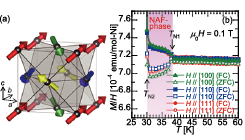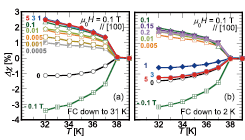Magnetic Anomaly due to the Non-Coplanar Antiferromagnetic Spin Structure in NiS2
Nakatsuji Group
Non-coplanar spin arrangements in frustrated magnets have attracted great interest because the associated spin chirality may induce exotic phenomena such as multiferroicity, topological Hall transport, and chiral spin liquid states. While most non-coplanar magnets are characterized by their ferromagnetic (FM) component, a purely antiferromagnetic (AF) all-in/all-out (AIAO) structure has recently been discovered in several 5d pyrochlore oxide. While this magnetic structure has zero net magnetic moment owing to the cancellation of the moments on the four vertexes of a tetrahedron, it has two types of AF variant, which are connected by the time-reversal operation, and permits a multi-domain state as in the case of FM materials [1]. In this system, it has been theoretically proposed that the magnetic domain wall (DW) induces a net uniform magnetization and hosts a gapless interface state with Fermi arcs [2]. Experimentally, the unconventional weak ferromagnetic (WF) moment and the anomalous magnetoconductivity have been observed in the AIAO-phase of Eu2Ir2O7 and Nd2Ir2O7, respectively [3]. As the domain physics is inherent to the AIAO structure, similarly interesting physics associated with the DW should generally emerge in other materials that host the non-coplanar AF spin structure. However, to date, there have been almost no reports on studies of domain phenomena related to the non-coplanar AF spin structure.

Fig. 1. (a) NAF structure of NiS2. Arrows indicate the Ni2+ magnetic moments [5]. (b) Temperature dependence of the magnetic susceptibility χ(T) = M(T)/H in the magnetic field of 0.1 T.

Fig. 2. Temperature dependence of Δχ(T) = {χ(T)−χ(39K)}/χ(39 K)×100% (the change in χ(T) from the one at 39K > TN1) obtained on heating in μ0H = 0.1 T // [100] after the field cooling (a) down to 31 K and (b) down to 2 K with various magnetic fields for the FC procedure μ0HFC = -0.1‐5 T.
The antiferromagnet NiS2 has the pyrite structure. The magnetic ion Ni2+ forms an fcc lattice, one of geometrical frustrated lattices. Neutron diffraction measurements have revealed that NiS2 exhibits a non-coplanar AF spin structure with four spin sublattices (NAF structure), similarly to the AIAO structure [Fig. 1(a)], in the temperature region between TN1 = 38 K and TN2 = 30 K, and the WF-phase below TN2 [4]. We have carried out detailed magnetization measurements using high-quality single crystals of NiS2 to reveal magnetic properties associated with the NAF structure [5].
A small but distinct hysteresis in the temperature dependence of the susceptibility χ(T) was observed in the NAF-phase [Fig. 1(b)]. While this type of hysteresis is not observed in a collinear antiferromagnet, a similar behavior has been reported for Eu2Ir2O7, suggesting that the behavior is inherent in the non-coplanar AF spin structure. To reveal the origin of the hysteresis, we performed the χ(T) measurement with the two field cooling (FC) processes, namely, (i) cooling down to 31 K in the NAF-phase, and (ii) cooling down to 2 K in the WF-phase under various FC magnetic fields μ0HFC between − 0.1 and 5 T. After the FC sequences, we changed the field at the lowest temperatures (31 or 2 K), and measured χ(T) in μ0H = 0.1 T.
The results in Fig. 2(a) obtained after the FC process (i), which corresponds to a direct magnetic field control of the NAF structure, show that χ(T) monotonically increases with increasing μ0HFC and saturates above 1 T. On the other hand, the results in Fig. 2(b) obtained after the FC process (ii), namely, the indirect magnetic field control of the NAF structure by aligning the WF moment in WF-phase, show the unusual μ0HFC dependence of χ(T). While χ(T) monotonically increases with increasing μ0HFC under μ0HFC ≦ 0.1 T, χ(T) under 0.1 T < μ0HFC ≦ 3 T decreases with increasing μ0HFC, and χ(T) under μ0HFC = 3 and 5 T exhibits almost the same behavior as the result with μ0HFC = 0 T. These observations indicate that the NAF structure can be controlled by using the WF-phase. In addition, the anomalous μ0HFC dependence of the magnetic hysteresis found in the NAF-phase strongly suggests that the small FM moment in the NAF-phase comes from the DWs.
References
- [1] T.-h. Arima, J. Phys. Soc. Jpn. 82, 013705 (2013).
- [2] Y. Yamaji and M. Imada, Phys. Rev. X 4, 021035 (2014).
- [3] J. J. Ishikawa, E. C. T. O’ Farrell, and S. Nakatsuji, Phys. Rev. B 85, 245109 (2012); K. Ueda et al., Phys. Rev. B 89, 075127 (2014).
- [4] K. Kikuchi et al., J. Phys. Soc. Jpn. 45, 444 (1978).
- [5] T. Higo and S. Nakatsuji, J. Phys. Soc. Jpn. 84, 053702 (2015).
